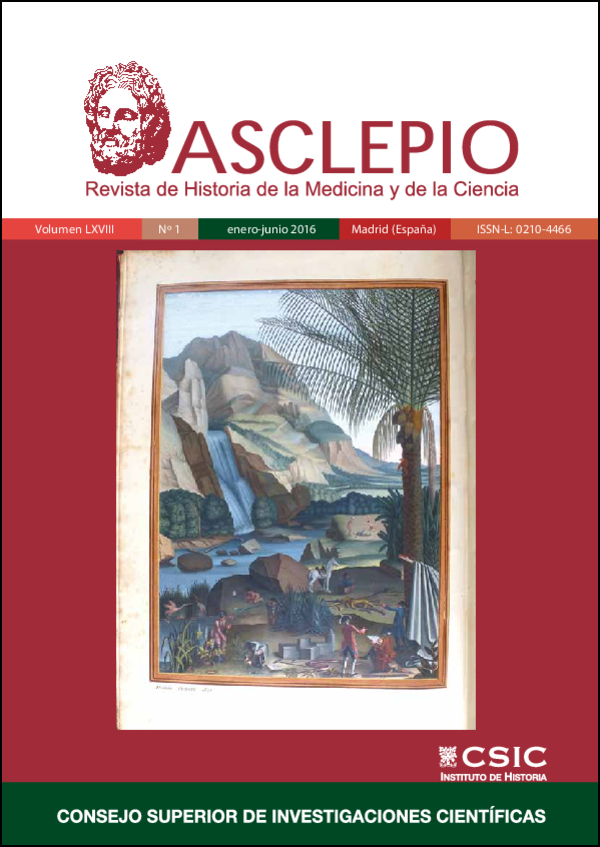Science in the Spanish Baroque: New documentary sources of Jerónimo de Ayanz
DOI:
https://doi.org/10.3989/asclepio.2016.01Keywords:
Jerónimo de Ayanz, Emmanuel Philibert of Savoy, Perpetual motion, Sphere of fire, Falling bodiesAbstract
Recently, a printed document of Jerónimo de Ayanz, acquired by the Biblioteca Nacional de España (the National Library of Spain), has revealed that this inventor was active until the very last days of his life and shows his interest in technology, research and science. The document, addressed to the Prince Emmanuel Philibert of Savoy, is one chapter of a book, of which no copies are known, that Ayanz had prepared in 1612 and that he probably wanted to publish with the support of the Prince. In this paper we present and comment this important text, where the author discusses central scientific subjects of his time such as the compulsory movement of the elements, the existence of vacuum, the possibility of perpetual motion, the sphere of fire and falling bodies.
Downloads
References
Barreiro Barreiro, José Luis (2000), Reproducción facsimilar de la edición de 1749 de Antoniana Margarita de Gómez Pereira. Santiago de Compostela y Oviedo, Universidad de Santiago de Compostela y Fundación Gustavo Bueno. PMCid:PMC88738
Díez del Corral, Francisco (2008), Blaise Pascal: la certeza y la duda. Madrid, Vision Net.
Fernández Duro, Cesáreo (1885), El Gran Duque de Osuna y su marina. Reimpreso en Madrid (2006), Renacimiento.
García-Diego, José Antonio; García Tapia, Nicolás (1990), Vida y técnica en el Renacimiento. Manuscrito de Francisco Lobato, vecino de Medina del Campo. Valladolid, Universidad de Valladolid.
García Tapia, Nicolás (1990), Patentes de invención españolas en el Siglo de Oro. Madrid, Ministerio de Industria y Energía.
García Tapia, Nicolás (1992), Del dios del fuego a la máquina de vapor: introducción de la técnica en Hispanoamérica. Valladolid, Ámbito Ediciones S.A.
García Tapia, Nicolás (1997), Los Veintiún libros de los ingenios y de las máquinas, atribuidos a Pedro Juan de Lastanosa. Zaragoza, Gobierno de Aragón.
García Tapia, Nicolás (2001), Un inventor navarro, Jerónimo de Ayanz y Beaumont. Pamplona, Gobierno de Navarra.
García Tapia, Nicolás; Carrillo Castillo, Jesús (2002), Turriano, Lastanosa, Herrera, Ayanz. Tecnología e imperio. Ingenios y leyendas del Siglo de Oro. Madrid, Nivola.
Guillaumin, Godfrey (2005), El surgimiento de la noción de evidencia: un estudio de epistemología histórica sobre la idea de evidencia científica. México D.F., Universidad Nacional Autónoma de México. PMid:15713986
Herrera, Rosa María (2012), “Historia del experimento barométrico”, Pensamiento matemático, 2, pp. 1-14, 5.
Mason, Stephen (2012), Historia de las ciencias 1: Desde la Antigüedad hasta el siglo XVII. Madrid, Alianza.
Navarro Brotóns, Víctor (1996), “Los Jesuitas y la renovación científica en la España del siglo XVII”, Studia historica. Historia moderna, 14 (1), pp. 15-44, 16.
Romo Feito, José (1985), La física de Galileo: la problemática en torno a la ley de caída de los cuerpos. Barcelona, Universidad Autónoma.
Published
How to Cite
Issue
Section
License
Copyright (c) 2016 Consejo Superior de Investigaciones Científicas (CSIC)

This work is licensed under a Creative Commons Attribution 4.0 International License.
© CSIC. Manuscripts published in both the print and online versions of this journal are the property of the Consejo Superior de Investigaciones Científicas, and quoting this source is a requirement for any partial or full reproduction.
All contents of this electronic edition, except where otherwise noted, are distributed under a Creative Commons Attribution 4.0 International (CC BY 4.0) licence. You may read the basic information and the legal text of the licence. The indication of the CC BY 4.0 licence must be expressly stated in this way when necessary.
Self-archiving in repositories, personal webpages or similar, of any version other than the final version of the work produced by the publisher, is not allowed.















